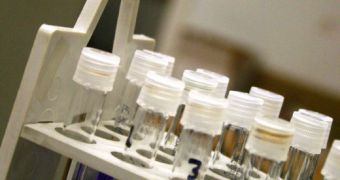Creating the best possible reactants and catalysts is the basic step in any chemical reaction, as long as experts know what they are trying to obtain. In recent years, chemists have noticed that nanoparticles featuring both platinum and gold make for an exquisite catalyst in a variety of chemical reactions related to the pharmaceutical industry. But the trouble with them was, until last week, the fact that they could not be readily produced in vast amounts that would have made a difference in the field. Now, scientists at the Rice University have managed a breakthrough and have devised a new method of producing the catalyst.
They have created gold-platinum nanorods, but coated with a layer of polymers. The innovation allows for the structures to be used with organic solvents, which are naturally favored by the drug industry over their inorganic counterparts. Large sectors of the chemistry industry also operate exclusively on organic compounds, so the new nanorods could be of use there too. Details of how the team has created the structures appear in the September 1st International Edition of the German scientific journal Angewandte Chemie.
Catalysts are essentially substances that influence the course of a chemical reaction, without actually being modified by it. They can be used to either make the reaction take place faster, or slower, entirely depending on the desired outcome. A reaction between the same elements could easily yield two different compounds, if different types of catalysts are used.
“There are some industrial reactions where drugmakers have no choice but to use platinum and palladium catalysts, but the majority of these are homogenous, which means they mix readily with reactants and are very difficult to remove. Because these heavy metals are toxic, they must be completely removed from the drug after its synthesis is completed. However, the removal of homogeneous catalysts is very time-consuming and expensive, which creates a big problem for pharmaceutical companies,” RU Associate Professor in Chemistry Eugene Zubarev, who is also the lead researcher on the new experiments, says.
“The selectivity of the coated gold and platinum nanorods will be very attractive to industry. For example, we found they had nearly 100 percent catalytic selectivity for the hydrogenation of terminal olefins. The early indications are very promising,” he concludes.

 14 DAY TRIAL //
14 DAY TRIAL //